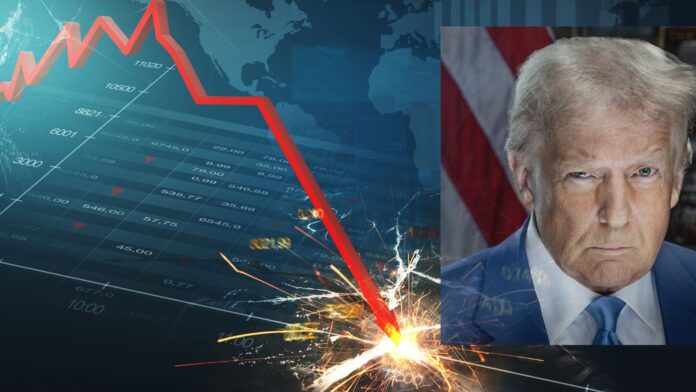Bitcoin Price Drops Amid Trump’s Tariff Announcements and Hot PCE Data
Bitcoin has experienced a week-long decline, with the cryptocurrency currently trading at $82,093.07, down from recent highs but still showing a slight 24-hour increase of 0.47%. Many investors wondering why Bitcoin crashed this week are looking at a broader de-risking trend among traders as market participants anticipate significant economic impacts from President Donald Trump’s upcoming reciprocal tariffs and react to hotter-than-expected inflation data.
Multiple Factors Behind the Crypto Decline
The reasons why the cryptomarket crashed this week can be attributed to several interconnected factors:
Hotter-Than-Expected PCE Inflation Data
Additional economic indicators showed:
- Personal Income increased by 0.8% month-over-month
- Personal Spending rose by 0.4% month-over-month
This higher-than-anticipated inflation reading suggests the Federal Reserve may maintain its restrictive monetary policy stance longer than previously expected. Currently, markets see only about a 10% chance of a 25 basis point interest rate cut in May, according to the CME FedWatch Tool. This monetary policy outlook helps explain why Bitcoin price has been dropping for one week.
Trump’s Comprehensive Tariff Plans
President Trump is set to implement a series of reciprocal tariffs on April 2, 2025, targeting countries with persistent trade surpluses with the United States. These “Liberation Day” measures are expected to affect approximately 15% of U.S. trading partners, dubbed the “Dirty 15” by Treasury Secretary Scott Bessent.
The tariffs include:
- Up to 25% on goods from Canada and Mexico, with some auto industry exemptions whose status remains unclear after Wednesday
- An additional 20% on Chinese imports, targeting supply chains allegedly linked to fentanyl production
- 25% on steel and aluminum imports (already in effect since mid-March)
- 25% tariffs on countries purchasing Venezuelan oil
- 12% tariffs on imported automobiles (effective April 3, 2025, at 12:01 am Eastern Time)
Potential targets include China, the European Union, Mexico, Vietnam, Taiwan, Japan, South Korea, and Canada – all countries with which the United States maintains significant trade deficits.
Market Reactions and Currency Movements
Following the PCE data release, the US Dollar remained resilient against major currencies, with the USD Index up 0.12% at 140.40. Weekly performance shows the dollar was strongest against the Japanese Yen (up 0.92%) while losing ground against the Australian Dollar (-0.36%) and Canadian Dollar (-0.26%).
This dollar strength typically creates headwinds for Bitcoin and other cryptocurrencies, which often move inversely to the USD during periods of economic uncertainty, contributing to why Bitcoin crashed this week.
Cryptocurrency Market Status
Despite the recent pullback, Bitcoin’s broader metrics remain relatively strong:
- Current price: $82,093.07
- 24-hour change: +0.47%
- Weekly change: -1.27%
- Monthly change: +5.50%
- Market capitalization: $1,629,085,674,154
- 24-hour trading volume: $17,494,645,733
- Circulating supply: 19.84 million BTC
- 24-hour transaction volume: 213.68K BTC
Market Outlook
For newcomers to the crypto market wondering why the cryptomarket crashed this week, analysts remain divided on the short-term outlook. The combined impact of persistent inflation and impending tariffs creates a challenging environment for risk assets.
Some market watchers suggest this correction is a normal pullback after significant gains earlier in the year, while others caution that escalating trade tensions could trigger further volatility. Particular concerns include:
- Reduced global liquidity: Economic uncertainty often leads investors to move capital to safer assets.
- Trade war escalation: China and the EU have already announced retaliatory measures against U.S. tariffs, with China imposing 10-15% counter-tariffs on American agricultural products.
- Supply chain disruptions: Potential tariffs on semiconductors could impact crypto mining operations and hardware costs.
- Currency market volatility: Fluctuations in forex markets can influence cryptocurrency trading patterns as investors adjust their cross-asset portfolios.
As President Trump’s “Liberation Day” approaches on April 2, cryptocurrency traders are closely monitoring both policy announcements and market reactions to gauge the next direction for digital assets in this evolving macroeconomic environment, seeking to understand if Bitcoin price will continue dropping for one week more or recover.
You may also like: President Trump Embraces Crypto Future: Promises Economic Growth and U.S. Financial Leadership




